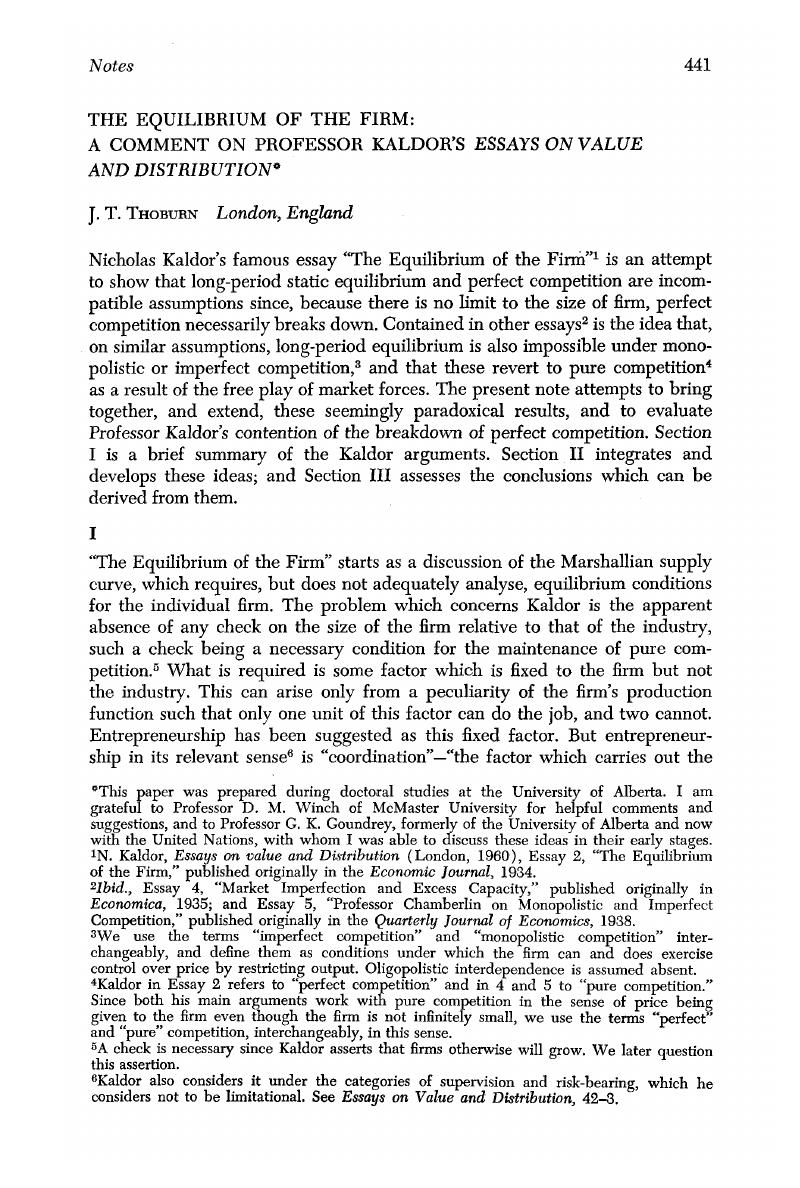No CrossRef data available.
Article contents
The Equilibrium of the Firm: A Comment on Professor Kaldor's Essays on Value and Distribution*
Published online by Cambridge University Press: 07 November 2014
Abstract

- Type
- Notes
- Information
- Canadian Journal of Economics and Political Science/Revue canadienne de economiques et science politique , Volume 33 , Issue 3 , August 1967 , pp. 441 - 444
- Copyright
- Copyright © Canadian Political Science Association 1967
Footnotes
This paper was prepared during doctoral studies at the University of Alberta. I am grateful to Professor D. M. Winch of McMaster University for helpful comments and suggestions, and to Professor G. K. Goundrey, formerly of the University of Alberta and now with the United Nations, with whom I was able to discuss these ideas in their early stages.
References
1 Kaldor, N., Essays on value and Distribution (London, 1960)Google Scholar, Essay 2, “The Equilibrium of the Firm,” published originally in the Economic Journal, 1934.Google Scholar
2 Ibid., Essay 4, “Market Imperfection and Excess Capacity,” published originally in Economica, 1935; and Essay 5, “Professor Chamberlin on Monopolistic and Imperfect Competition,” published originally in the Quarterly Journal of Economics, 1938.
3 We use the terms “imperfect competition” and “monopolistic competition” interchangeably, and define them as conditions under which the firm can and does exercise control over price by restricting output. Oligopolistic interdependence is assumed absent.
4 Kaldor in Essay 2 refers to “perfect competition” and in 4 and 5 to “pure competition.” Since both his main arguments work with pure competition in the sense of price being given to the firm even though the firm is not infinitely small, we use the terms “perfect” and “pure” competition, interchangeably, in this sense.
5 A check is necessary since Kaldor asserts that firms otherwise will grow. We later question this assertion.
6 Kaldor also considers it under the categories of supervision and risk-bearing, which he considers not to be limitational. See Essays on Value and Distribution, 42–3.
7 Ibid., p. 42.
8 Kaldor's definition of “dynamics” includes movement towards equilibrium in a (static) context of unchanging parameters. This is a rather broader definition than is often used, but support for Kaldor's position is derived from the widely accepted idea that the tendency to static equilibrium is itself a dynamic matter. See, for example, Hicks, J. R., Capital and Growth (Oxford, 1965), 18.Google Scholar
9 Essays on Value and Distribution, 46.
10 “Monopolistic or Imperfect Competition,” Quarterly Journal of Economics, 1937 Google Scholar; and “Reply” (to Kaldor's “Essay 5”), Quarterly Journal of Economics, 1938. Both Chamberlin articles are reprinted together in revised form in The Theory of Monopolistic Competition (8th ed., Cambridge, Mass., 1962)Google Scholar, chap. 9, “The Difference between Monopolistic and Imperfect Competition.” Chamberlin's final position is outlined in his Towards a More General Theory of Value (New York, 1957)Google Scholar, chap. 3, “Monopolistic Competition Revisited”; see also chap. 9, “Proportionality, Divisibility, and Economies of Scale,” and “Reply to Mr. McLeod and Mr. Hahn.”
11 Kaldor does not explicitly state that perfect competition breaks down into imperfect competition but if firms can and do grow, no other result (except possibly oligopoly) is possible. Oligopoly might occur if some firms grow much faster than others.
12 They were not necessary conditions because the existence of indivisibilities in the long run would have merely imparted “undulations” to the average cost runs and would not therefore have checked the firm's growth. We might also note, in passing that the existence of indivisibilities might not prevent a breakdown into pure competition if we introduce the not unreasonable assumption that more firms enter the industry in response to excess profits than are actually required to eliminate those excess profits. If so, new entry may force the demand curve of exising firms back beyond the high point of the relevant “undulation” on the long-run average cost curve, and the firm can profitably lower output. If this process is repeated, pure competition is established.
13 Monopolistic Competition and General Equilibrium Theory (Cambridge Mass. 1960) 153–5.Google Scholar
14 I am indebted to D. M. Winch for clarifying my thoughts on this point.
15 The fact that we have reintroduced entrepreneurship in order to account for growth does not necessarily affect this conclusion, if it only imparts a rising section to the average cost curve. Firms will contract output in order to maintain excess profits providing average costs do not rise at lower outputs.




